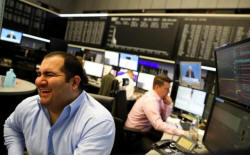|
It's not just the VIX -
low volatility is everywhere
 Send a link to a friend
Send a link to a friend
 [May 10, 2017]
By Jamie McGeever and Vikram Subhedar [May 10, 2017]
By Jamie McGeever and Vikram Subhedar
LONDON
(Reuters) - The current slump in expectations of market volatility is
not just a stock market phenomenon -- it is the lowest it's been for
years across fixed income, currency and commodity markets around the
world.
It shows little sign of reversing, which means market players are
essentially not expecting much in the way of shocks or sharp movements
any time soon. It's an environment in which asset prices can continue
rising and bond spreads narrow further.
The improving global economy, robust corporate profitability, ample
central bank stimulus even as U.S. interest rates are rising, and some
fading political risk from elections have all contributed to create a
backdrop of relative calm.
There is little evidence of investors hedging -- or seeking to protect
themselves -- from adverse conditions.
It is most notably seen in the VIX index of implied volatility on the
U.S. S&P 500 stock index, the so-called "fear index".
But implied volatility across the G10 major currencies is its lowest in
three years, and U.S. Treasury market volatility its lowest in 18 months
and close to record lows.

The VIX, meanwhile, has dipped to lows not seen since December 2006, is
posting its lowest closing levels since 1993, and is on a record run of
closes below 11. By comparison, it was at almost 90 at the height of the
financial crisis.
Not much current "fear", then.
Implied volatility is an options market measure of investors'
expectation of how much a certain asset or market will rise or fall over
a given period of time in the future.
It and actual volatility can quickly become entwined in a spiral lower
because investors are less inclined to pay up for "put" options --
effectively a bet on prices falling -- when the market is rising.
If a shock does come the cost of these "puts" would shoot higher as
investors scramble to buy them. Surging volatility is invariably
associated with steep market drawdowns.
[to top of second column] |

A trader at the Frankfurt stock exchange reacts on morning trading
results in Frankfurt, Germany, May 8, 2017. REUTERS/Kai Pfaffenbach/File
Photo

According to Deutsche Bank's Torsten Slok, an investor betting a year ago that
the VIX would fall -- shorting the index -- would have gained around 160 percent
today. Conversely, an investor buying the VIX a year ago assuming it would rise
would have lost 75 percent.
None
of the huge political surprises of the past 12-18 months -- from Brexit to
Donald Trump -- have managed to puncture the steady gain in risky assets,
pushing actual volatility ever lower.
This phenomenon is playing out in major stock markets and the ripple effects are
being felt in all asset classes.
Graphics
VIX - http://reut.rs/2qYRiUr
VIX long vs short - http://reut.rs/2pjgOaG
Oil volatility - http://reut.rs/2q1LEn7
G10 FX Volatility - http://reut.rs/2pyjcqm
FX vol vs 5-year average - http://reut.rs/2pYmDJD
U.S. Treasury volatility - http://reut.rs/2qYMb6H
VIX below 11 - http://reut.rs/2q1TvB4
(Graphics by Vikram Subhedar; Editing by Jeremy Gaunt)
[© 2017 Thomson Reuters. All rights
reserved.] Copyright 2017 Reuters. All rights reserved. This material may not be published,
broadcast, rewritten or redistributed.
 |